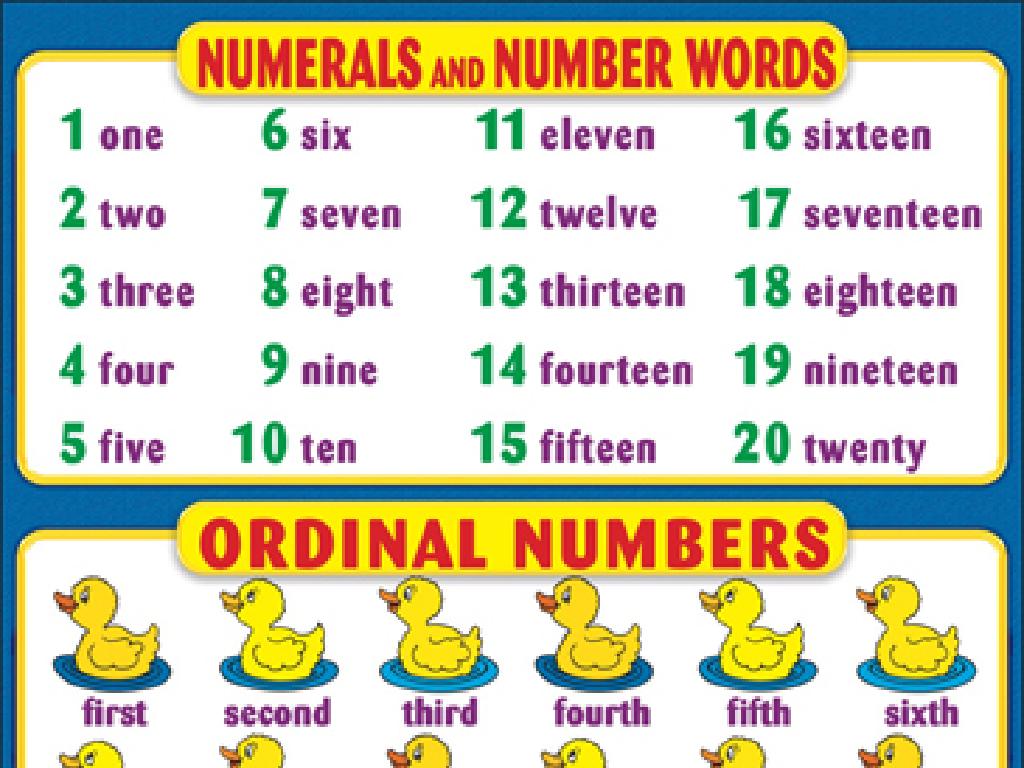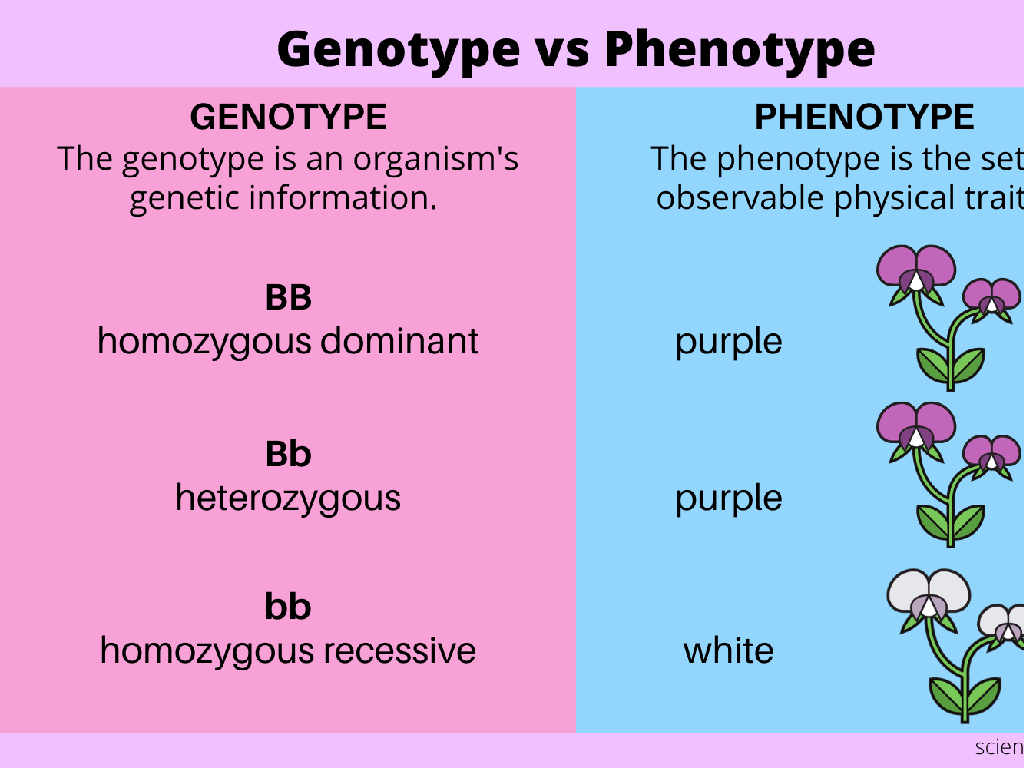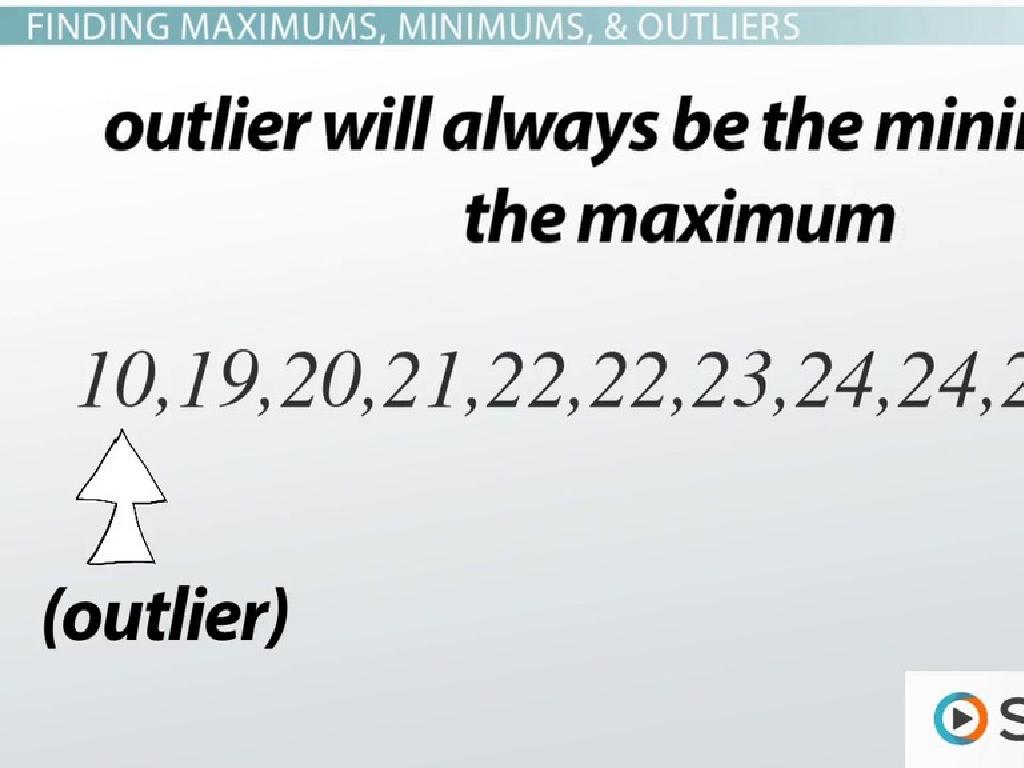Multiplication Facts To 10: Find The Missing Factor
Subject: Math
Grade: Fourth grade
Topic: Multiplication
Please LOG IN to download the presentation. Access is available to registered users only.
View More Content
Today’s Adventure: Multiplication Facts to 10!
– ‘Times’ symbol in multiplication
– The ‘times’ symbol (×) means to multiply, like 3 × 4 means 3 groups of 4
– Multiplication as fast addition
– Instead of adding 4 + 4 + 4, we can quickly multiply 3 × 4 to get 12
– Finding missing factors
– To find a missing factor, think: what number times another equals the product?
– Practice with examples
– Let’s try: 5 × ? = 20. What number can we multiply by 5 to get 20?
|
This slide introduces students to the concept of multiplication as a method for quick addition of the same number multiple times. Begin by explaining the ‘times’ symbol and how it represents the idea of multiplication. Emphasize that multiplication is a shortcut for adding groups of the same number, which saves time and effort. Illustrate with examples, such as 3 groups of 4 items each. Then, guide students on how to find missing factors in multiplication equations by using inverse operations or memorized facts. Provide practice problems for the class to solve together, reinforcing the concept of multiplication as repeated addition and the process of finding missing factors.
Understanding Multiplication
– Multiplication as repeated addition
– Think of it as adding the same number over and over
– Example with apples
– Like having 2 apples, 3 times: 2 + 2 + 2
– Groups of equal size
– Multiplication helps us with equal groups, like 4 groups of 3 cookies
– Finding missing factors
– If we know 4 x ? = 12, we find the number that fits
|
This slide introduces the concept of multiplication to fourth graders by relating it to repeated addition, which they are already familiar with. Use everyday examples, such as adding apples, to illustrate the point. Explain that multiplication is a faster way to add the same number multiple times. Emphasize that it’s about combining equal groups to find a total. Then, transition to finding missing factors by using familiar multiplication facts. For instance, if we know that 4 times a certain number equals 12, we can figure out that the missing number is 3. Encourage students to think of multiplication as a shortcut for addition and to use this understanding to solve for unknowns in equations.
Mastering Multiplication Facts to 10
– Memorize the multiplication table
– Know your times tables up to 10×10 for quick recall
– Recognize patterns in multiplication
– Understand that any number times 1 equals the number itself
– Use skip counting for answers
– Count by numbers to multiply without the table
– Practice with missing factors
|
This slide is aimed at helping fourth-grade students solidify their understanding of multiplication facts up to 10. Encourage students to memorize the multiplication table as it is the foundation for their math skills. Highlight the patterns found in multiplication, such as any number multiplied by 1 remains unchanged, which can help them remember the facts more easily. Teach them to use skip counting as a method to find the product of two numbers, especially when they’re stuck. For example, to find 4×3, they can count by fours 4, 8, 12. Lastly, provide exercises where one factor is missing, and they have to find it using the multiplication facts they’ve learned. This will prepare them for more complex problems and ensure they understand the concept deeply. In the next class, have a quiz or a fun activity to reinforce these concepts.
Finding the Missing Factor in Multiplication
– Understanding multiplication factors
– Factors are numbers we multiply to get a product
– Steps to find the missing number
– Divide the product by the known factor to find the missing one
– Example: 4 x ? = 20
– Divide 20 by 4 to find the missing factor
– Example: ? x 5 = 35
– Divide 35 by 5 to find the missing factor
|
This slide is aimed at helping fourth-grade students understand the concept of factors in multiplication and how to find a missing factor in a multiplication sentence. Begin by explaining that factors are numbers multiplied together to get a product. To find a missing factor, students can use division: divide the product by the known factor. For example, in 4 x ? = 20, dividing 20 by 4 gives the missing factor, which is 5. Similarly, for ? x 5 = 35, dividing 35 by 5 gives 7 as the missing factor. Encourage students to practice with different numbers and to check their work by multiplying the factors to see if they get the original product.
Let’s Practice Multiplication Together!
– Solve problems with one missing factor
– Find the number that completes the equation, e.g., _ x 3 = 9
– Use multiplication tables as a tool
– Refer to your tables to quickly find answers
– Pair up for group activity
– Work with a partner to solve given problems
– Share solutions with the class
– Discuss how you found your answers
|
This slide is designed to engage students in a hands-on group activity to reinforce their understanding of multiplication facts up to 10. Begin by explaining how to approach solving multiplication problems when one factor is unknown. Demonstrate the use of multiplication tables as a reference to find the missing factor quickly. Organize the class into pairs and distribute practice problems for them to solve together, fostering collaboration and peer learning. After the activity, have pairs share their solutions and discuss the strategies they used to find the missing factors. This will help students learn from each other and gain confidence in their multiplication skills.
Multiplication Games: Fun with Factors
– Games reinforce multiplication
– Fun and engaging learning
– Games turn math into an enjoyable activity, helping memorize facts
– Examples of multiplication games
– ‘Factor Bingo’, ‘Multiplication War’, and ‘Roll & Multiply’
– Practice with peers
– Play games with classmates to strengthen skills and teamwork
|
This slide introduces the concept of using games to make learning multiplication facts more enjoyable for fourth graders. Emphasize how incorporating play into education can help students reinforce their multiplication skills in a fun, less stressful environment. Provide examples of games such as ‘Factor Bingo’, where students fill in bingo cards with products, ‘Multiplication War’, a card game where the highest product wins, and ‘Roll & Multiply’, using dice to generate multiplication problems. Encourage students to play these games with their peers, which not only helps them practice multiplication but also fosters a sense of community and teamwork in the classroom. The teacher should prepare these games and guide the students on how to play them, ensuring that the learning objectives are met while the students are engaged and having fun.
Class Activity: Multiplication Bingo
– Receive your unique Bingo card
– Listen for the called out products
– Solve for missing factors on your card
Use multiplication facts to find the number that completes the equation.
– Aim for five correct in a row to win!
|
This interactive activity is designed to help students practice and reinforce their multiplication facts up to 10. Each student will receive a Bingo card filled with multiplication problems missing one factor. As the teacher calls out different products, students must quickly calculate the missing factor in each equation on their card. The first student to solve for the missing factors and get five in a row (horizontally, vertically, or diagonally) shouts ‘Bingo!’ and wins. Teachers should prepare multiple Bingo cards in advance, ensure that each card is unique, and have a list of products to call out. Possible variations of the game could include ‘Four Corners Bingo,’ ‘Blackout Bingo,’ where students must fill the entire card, or ‘Challenge Bingo’ with more complex multiplication problems for advanced students.
Wrapping Up: Multiplication Facts to 10
– Recap: Multiplication facts to 10
– Practice makes perfect
Regular practice helps in memorizing the facts.
– Homework: Missing factors worksheet
Fill in the blanks to find the missing numbers.
– Next class: Quick recall quiz
Get ready to show how fast you can be!
|
As we conclude today’s lesson, remind the students of the importance of mastering multiplication facts up to 10. Emphasize that consistent practice is key to becoming quick and accurate at identifying missing factors. For homework, assign a worksheet that requires students to fill in missing factors in multiplication equations. This will reinforce their understanding and prepare them for a quick recall quiz in the next class. Encourage them to use strategies learned in class to complete the worksheet and to time themselves to improve their speed.






